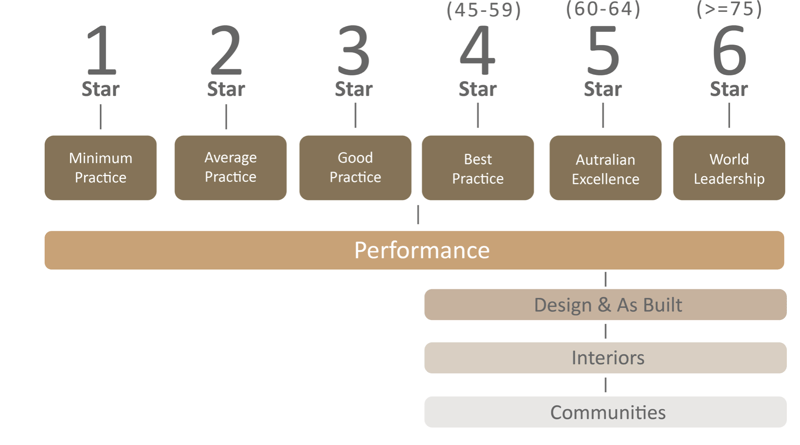3 min read
Section J vs. JV3 - When to use Which Compliance Method
What’s the difference between a Section J and JV3?
A JV3 assessment and a Section J assessment are both methods of...

Green Star's mission is to assess the sustainable design, construction and operation of buildings, fitouts and entire communities. In a world where climate change is becoming a formidable issue, minimising our carbon footprint and energy consumption has never been more important. However, this doesn't mean that your project has to suffer. In addition to ensuring sustainable design and construction practices, Green Star is also bent on boosting productivity and improving the health and well-being of building occupants through thoughtful design.

Green Star incorporates the use of four (4) assessment tools to provide a detailed assessment of the sustainable capabilities of both buildings and communities. The entire body of Green Star was brought into fruition because although Australia accounts for 0.33% of the world’s population, we have one of the highest greenhouse gas emissions per capita (Yu, Wiedmann, Crawford, Tait, 2016.).
Each assessment tool follows the same scoring system. Within each assessment tool you are given the opportunity to achieve one hundred (100) 'core' points and ten (10) 'innovation' points.
See below for the rating brackets:

Prices can vary greatly for each stage of the assessment, so please feel free to submit your plans for an accurate and project-specific fee proposal.
Choosing non-toxic building materials does as much good to the tenants of the building as to the environment. For paints, choosing non to low volatile organic compound (VOC) paints is best since it has less gas which means less fumes and smell. Low to non-VOC paints are also less likely to trigger serious health reactions when inhaled.

LED lights are known to be more energy efficient than traditional lights
Windows aid in blocking sunlight, wind, and noise. We have the choice to use cheaper alternatives, however in doing so, we may not be designing to maximise sunlight exposure which will lead to an increase in electricity consumption. This is why more and more businesses are using Suntuitive technology. This technology is designed to reduce your carbon footprint by providing natural passive heating through the glass panes.

In our previous article, we have discussed the energy efficient Suntuitive technology and what sets it apart from single glazed and double glazed windows.

The Green Star – Performance assessment tool aims to improve sustainability and well-being on the neighbourhood, precinct, and community scale. Within this assessment tool you will find thirty-seven (37) opportunities to gain ‘core’ points and five (5) more opportunities to gain ‘innovation’ points. Based on the amount of points you earn; you will be award with a rating between one (1) and six (6) stars.

Within this credit lies five (5) criteria which are designed to ensure that all building services operate to their full potential.
Each criterion can award up to one (1) point to your total rating. However, to be eligible for these points you must comply with the ‘Environmental Performance Targets’ as a conditional requirement.
Within this credit lies one (1) criterion designed to ensure that the project can adapt to changes in climate through design solutions included into the building’s infrastructure.
Within this credit lies two (2) criteria which are there to encourage the development and distribution of information regarding operations, maintenance and building use to facility management staff and all occupants of the building.
Each criterion can award up to one (1) point to your total rating.
Within this credit lies two (2) criteria designed to set targets, and measure and monitor the progress towards those targets.
Each criterion can award up to one (1) point to your total rating.
Within this credit lies two (2) criteria which are there to reduce building energy and water consumption, as well as capture and process data collected through an effective metering system.
Each criterion can award up to one (1) point to your total rating. However, to be eligible for these points you must comply with the ‘Effective Metering’ criterion as a conditional requirement.
Within this credit lies two (2) criteria which are designed to ensure that the project site and its environment is responsibly managed throughout its lifespan.
Each criterion can award up to one (1) point to your total rating. However, to be eligible for these points you must comply with the ‘Environmental Management Plan’ criterion as a conditional requirement.
Continue reading for 30 more opportunities to gain points towards your 6-star rating

Continue reading for 26 more opportunities to gain points towards your 6-star rating


Continue reading for 28 more opportunities to gain points towards your 6-star rating.

Green Star certification plays a crucial role in minimising greenhouse gas emissions through sustainable building practices. Certified buildings are designed and constructed to be highly energy-efficient, significantly reducing the reliance on non-renewable energy sources.
By focusing on sustainable design principles, such as improved insulation, energy-efficient HVAC systems, and the use of renewable energy, Green Star-certified buildings can achieve up to 66% less electricity consumption and up to 62% fewer greenhouse gas emissions compared to non-certified buildings.
Achieving a Green Star rating offers numerous benefits, including substantial reductions in energy use, greenhouse gas emissions, and water consumption. Certified buildings can consume up to 66% less electricity, emit up to 62% fewer greenhouse gases, and use up to 51% less water.
Getting a project Green Star certified might sound daunting. The certification process might sound like it requires a lot of effort and resources. In this article we will talk about simple methods that can help improve Green Star Ratings.
Choosing non-toxic building materials does as much good to the tenants of the building as to the environment. For paints, choosing non to low volatile organic compound (VOC) paints is best since it has less gas which means less fumes and smell. Low to non-VOC paints are also less likely to trigger serious health reactions when inhaled.
What’s the difference between a Section J and JV3?
A JV3 assessment and a Section J assessment are both methods of...
To ensure a seamless approval process that doesn't hold you down or end up costing more than it should, it's critical...
With the industry reaching new material heights, creating products which are physically beneficial to the environment,...
FOR IMMEDIATE RELEASE
Sydney, 11 March 2025
Certified Energy is pleased to announce our...